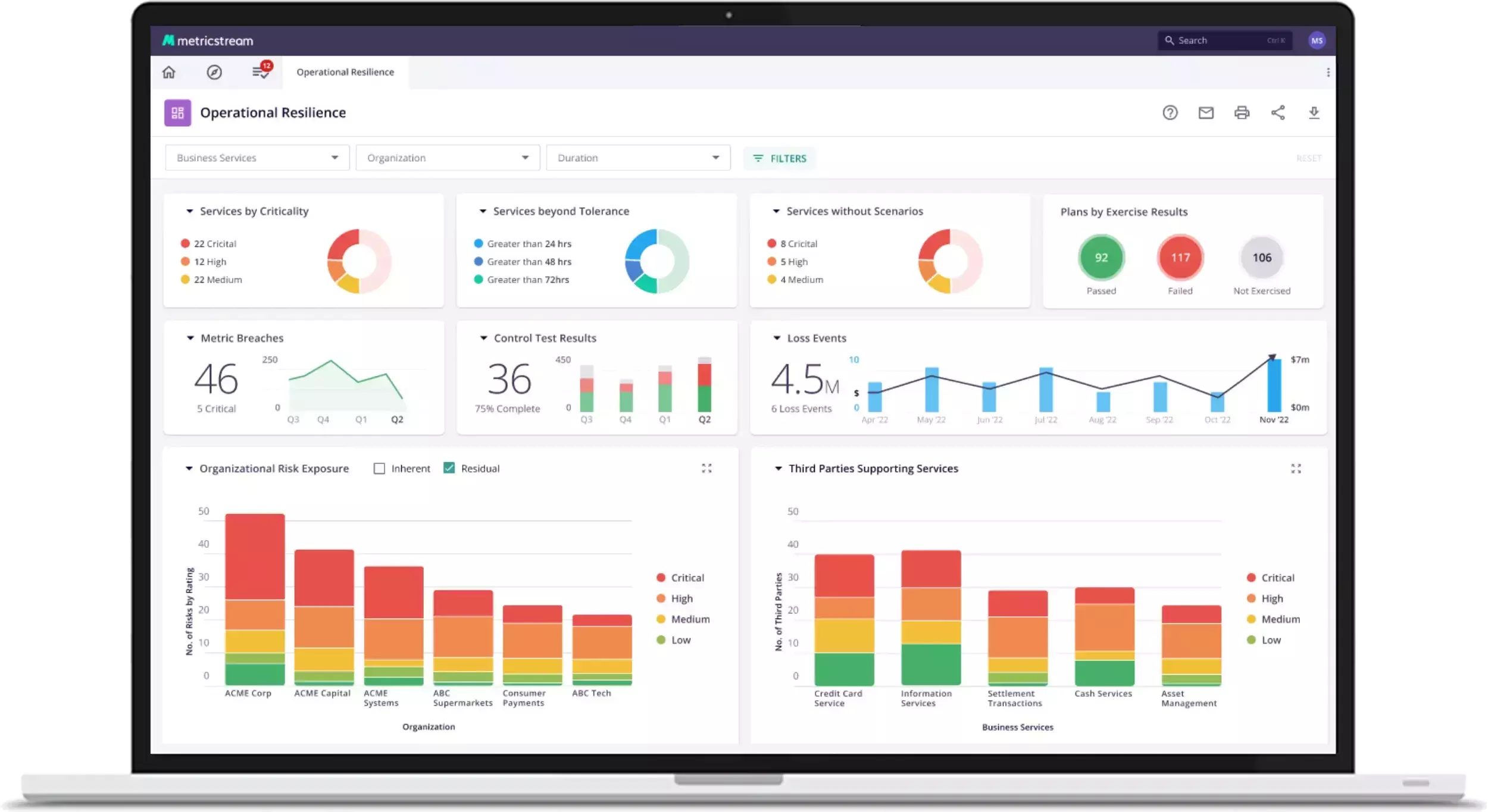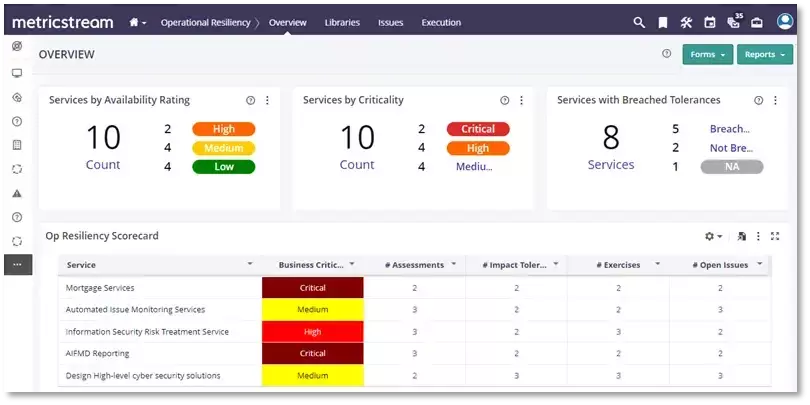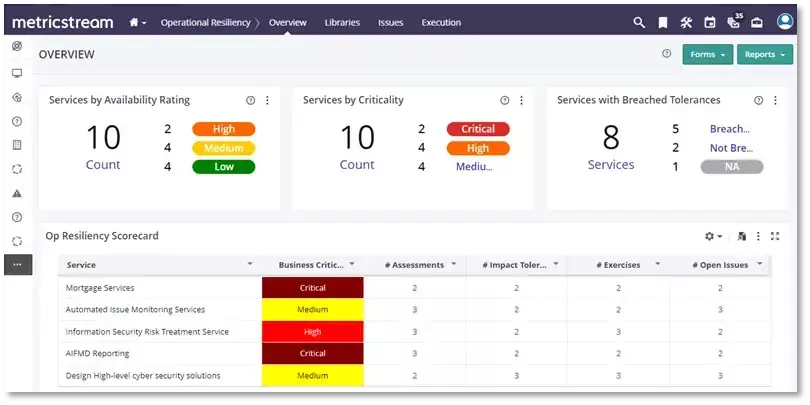Operational Resilience Management Software
Measure Your Program Outcomes

- 67%
improvement in risk reporting visibility and efficiency for the executive management and board

- 87%
reduction in the time taken to create and review a business impact analysis

- 80%
increase in risk and control framework-related operational efficiency


Prevent, Respond Faster, and Recover Better from Business Disruptions
The MetricStream Operational Resilience Management software enhances risk visibility across the enterprise, enabling effective mitigation and faster recovery from adverse risk events. Built on the MetricStream Platform, the operational resilience software supports today’s dynamic business needs with automated workflows, collaboration, and real-time reporting. It brings all aspects of the operational resilience framework on a single unified platform by seamlessly embedding risk management practices into your business continuity planning, allowing preparation for and speedy recovery from potential disruptions. The software gives organizations the ability to break down restrictive silos and ensure integration across various business functions while strengthening resiliency.
How Our Operational Resilience Software Helps You


Identify Critical Processes and Services, Map Dependencies
Prepare for recovery from risk events with a complete view of risk information, connections, and dependencies critical to maintaining or restoring systems, data, controls, compliance, and processes. Leverage the software’s centralized library to store and manage risks related to critical business processes, services, assets, data, applications, people, third parties, facilities, threats and vulnerabilities, and more.
Improved Risk Exposure Calculations with Impact Tolerances
Define impact tolerances, i.e. metrics that specify acceptable levels of disruption, for important business services. Continuously assess and monitor these metrics, both qualitative and quantitative, to keep them within threshold limits, identify potential threats, and mitigate them proactively.
Continuous Risk and Resilience Self-Assessments
Effortlessly plan, schedule, and perform self-assessment surveys and route the results for review and approval. Provide ratings or rankings for each business service for systematic prioritization, assess the organization's tolerance for disruptions or adverse events affecting each business service, and confirm compliance with operational resilience policies and procedures, including regulatory requirements, internal controls, and best practices.
Conduct Scenario Analysis and Testing
Identify and document plausible scenarios that can impact critical business operations. Test each of these scenarios through simulations. Record the learnings from these scenario testing exercises for further review and analysis. Refine and enhance the organization's operational resilience strategy based on these learnings, including updating response plans, improving communication protocols, and strengthening mitigation measures.
Ensure Business Continuity and Manage Crisis Better
Create, maintain, and manage continuity plans from pre-defined templates. Improve visibility by linking these plans to critical IT assets, business processes, locations, controls, and key contacts. Efficiently create and maintain emergency communications trees and distribution lists, as well as emergency notification templates across more than 25 distinct communications channels to ensure business-critical functions continue to operate.
Leverage AI-Powered Issue and Action Management
Report and manage issues and action plans triggered by risk and resilience assessments, scenario testing, and business impact analysis. Leverage AI capabilities to eliminate duplication of issues and expedite issue remediation across operational risk, cyber risk, business continuity, and third-party risk management programs. Define and track the sequence of events to ensure business recovery and program performance accountability.
How Our Operational Resilience Software Benefits You
- Strengthen business resilience with a coordinated and agile strategy for recovery from business disruptions
- Minimize redundant costs, tools, effort, and data by consolidating all risk and resilience-related data on a single, connected platform
- Enhance decision-making with contextual, real-time intelligence delivered through advanced reports and analytics
- Efficiently mitigate risks from operations, vendors, and IT infrastructure
Frequently Asked Questions
Operational resilience software is a technology solution that assists organizations in managing and strengthening their operational resilience programs. By bringing all aspects of the operational resilience framework on a single unified platform, it enhances enterprise-wide risk visibility, and enables effective mitigation and faster recovery from adverse risk events.
Operational resilience software should include features for risk assessment and management, incident tracking and response, business continuity planning, resilience testing, compliance management, data analytics, and reporting. It should offer integration capabilities, a user-friendly interface, and scalability to meet the needs of organizations. With these features, operational resilience software empowers organizations to manage and enhance their resilience capabilities, ensuring business continuity and safeguarding critical assets and operations.
Operational resilience management is a broader approach aimed at building resilience and ensuring continuity of operations in the face of disruptions, while Operational Risk Management (ORM) focuses on managing specific risks to prevent disruptions. While ORM deals with risk mitigation, Operational Resilience Management deals with resilience-building and continuity planning.
Operational resilience software is essential due to the growing complexity of business environment and increasing disruptions. It offers centralized management for risk assessment, incident response, and business continuity planning and automates repeatable tasks providing better efficiency. By enhancing risk visibility, facilitating efficient incident management, and supporting compliance, it ensures organizations can adapt and recover swiftly, maintaining business continuity and safeguarding critical operations.















